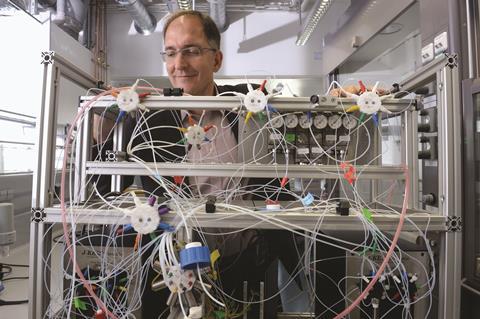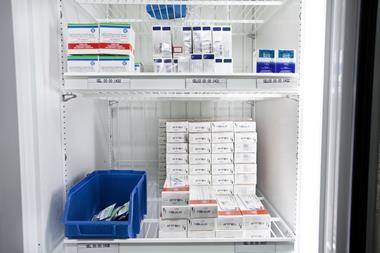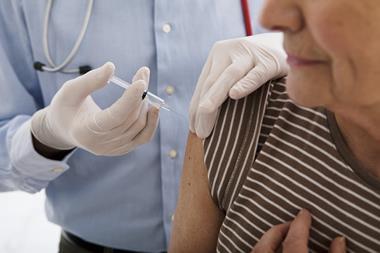Vaxxilon aims to simplify vaccine development by replacing biological components with well-defined synthetic molecules
Making a vaccine is complex. Some of the best antigens for recognising bacteria are the sugars decorating their surfaces. But these must be cultured, isolated and purified. They also often don’t stimulate strong immune responses on their own, so must be attached to strongly immunogenic proteins to make conjugate vaccines.

But there is potentially another way – start-up company Vaxxilon is working on ways to create synthetic vaccines, which could be more potent and more stable than conventional versions. Vaxxilon was set up in June 2015 by German chemist Peter Seeberger, director of the Max Planck Institute for Colloids and Surfaces in Potsdam, with backing from the Max Planck Society and Swiss firm Actelion Pharmaceuticals.
The company is initially aiming to improve on existing vaccines against pneumococcal infections, which cause over one million deaths per year. Pfizer’s Prevnar 13 protects against 13 serotypes of the microbe, generating sales of over $6 billion in 2015; Merck & Co’s Pneumonovax 23 is an older vaccine, but covers 23 serotypes and still sold $500 million in 2015. Seeberger suggests that both have several important limitations. ‘The company can illustrate the value of its technology in this area,’ he says. ‘We think we can fix Prevnar and add additional serotypes.’
‘Pneomococcus is a good initial target as demand is increasing,’ says Amey Pathak, healthcare analyst at Future Market Insights. By 2025, demand is expected to reach 380 million doses of vaccine per year, compared to 150 million in 2013.
Well-defined compounds
‘The premise of our research is to go from ill-defined biological molecules to well-defined pharmaceutical compounds,’ Seeberger says. Bacterial polysaccharides can be 500 sugars long – impossible to synthesise. Vaxxilon first identifies the repeating units of surface sugars, especially the terminal sugar, and screens fragments to find antigens. The best are tested in an animal model. ‘A lot of people initially thought chemistry would not be a good way, because carbohydrates are so complicated,’ says Seeberger. ‘But really you are talking about sticking together monosaccharide building blocks.’
Vaxxilon has mapped out a path to clinical trials for pneumococcus, potentially in 2018, with German regulators. The first test will involve a synthetic carbohydrate fragment joined to a protein that stimulates the immune system. This is especially important for children under two years old, who cannot recognise bacterial sugars as foreign entities.
But the company is also working on a small molecule replacement for the protein, using α-galactosylceramide (αGal-Cer), an immune stimulant. ‘The next step is to develop a fully synthetic vaccine, which will be even more stable and actually more potent,’ says Seeberger.
Synthetic gains
A wholly synthetic vaccine could mean speedier creation of new antigens via a screening library of carbohydrates. Eliminating the protein could also simplify or remove the need for cold storage throughout the supply chain. ‘The idea is to create a vaccine that will be stable at room temperature,’ explains chief executive Tom Monroe. ‘Because of the protein you have to keep it in a cold chain,’ says Seeberger. ‘Go to the tropics and this can represent 50% of the cost.’ Cutting out the protein could even reduce the number of injections required for immunization, and open up nasal, oral or patch-based dosing routes.
Finally, there is simplification and cost reduction inherent in manufacturing a fully synthetic vaccine, as αGal-Cer and the carbohydrate are chemically synthesised. ‘We would essentially be changing from two biological processes to two chemical ones,’ explains Monroe.
Once its testing library of polysaccharide fragments is established, Vaxxilon will be able to hunt for antigens to virtually any pathogen that expresses carbohydrates. ‘There are 27 pathogens for which we have vaccines for today,’ notes Monroe. ‘There are dozens, if not hundreds, of bugs that we could potentially make vaccines for.’ One possibility is Clostridium difficile, a common hospital-acquired infection, and one of the biggest causes of diarrhoea worldwide
‘We are at the stage today where we can make virtually anything,’ says carbohydrate chemist Todd Lowary of the University of Alberta in Canada. ‘It’s fairly straightforward to make these molecules but Peter’s group is really pushing the envelope in terms of the complexity of structures.’ He suggests the biggest challenge is not the chemistry: ‘You can vaccinate and get antibodies,’ he notes. ‘But that doesn’t always mean you get protection. That’s harder to predict.’
Cometh the chemist
Vaccine departments in industry are almost invariably run by biologists, says Seeberger. ‘Chemists have not got into the vaccine game,’ he adds. ‘In the next 20 years there will be a paradigm shift and [chemists’ involvement] will become normal. People will do medicinal chemistry for carbohydrates like for small molecules,’ tweaking to increase stability or potency.
Last November, Vaxxilon won the Falling Walls Venture event in Berlin, Germany. Seeberger described the award as a ‘huge validation’ and a ‘tremendous boost for those who work at the company.’












No comments yet